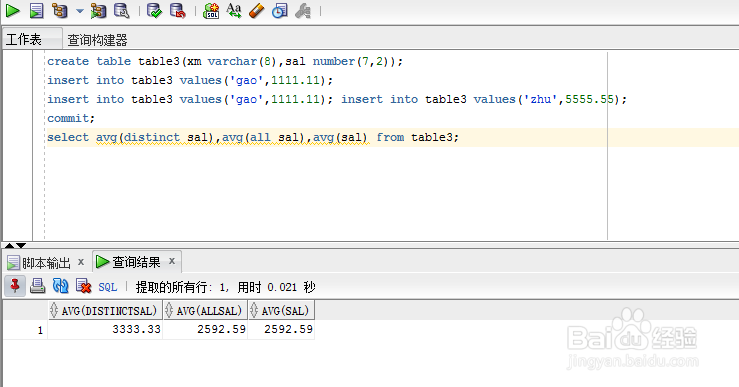1、AVG([distinct|all]x)【功能】统计数据表选中行x列的平均值。【参数】all表示对所有的值求平均值,distinct只对不同的值求平均值,默认为all 如果有参数distinct或all,需有空格与x(列)隔开。【参数】x,只能为数值型字段【返回】数字值【示例】环境:create table table3(xm varchar(8),sal number(7,2));insert into table3 values('gao',1111.11);insert into table3 values('gao',1111.11); insert into table3 values('zhu',5555.55);commit;执行统计: select avg(distinct sal),avg(all sal),avg(sal) from table3;结果: 3333.33 2592.59 2592.59
2、SUM([distinct|all]x)【功能】统计数据表选中行x列的合计值。【参数】all表示对所有的值求合计值,distinct只对不同的值求合计值,默认为all 如果有参数distinct或all,需有空格与x(列)隔开。【参数】x,只能为数值型字段【返回】数字值【示例】环境:create table table3(xm varchar(8),sal number(7,2));insert into table3 values('gao',1111.11);insert into table3 values('gao',1111.11);insert into table3 values('zhu',5555.55);commit;执行统计:select SUM(distinct sal),SUM(all sal),SUM(sal) from table3;结果: 6666.66 7777.77 7777.77
3、STDDEV([distinct|all]x)【功能】统计数据表选中行x列的标准误差。【参数】all表示对所有的值求标准误差,distinct只对不同的值求标准误差,默认为all 如果有参数distinct或all,需有空格与x(列)隔开。【参数】x,只能为数值型字段【返回】数字值【示例】环境:create table table3(xm varchar(8),sal number(7,2));insert into table3 values('gao',1111.11);insert into table3 values('gao',1111.11);insert into table3 values('zhu',5555.55);commit;执行统计:select STDDEV(distinct sal),STDDEV(all sal),STDDEV(sal) from table3;结果: 3142.69366257674 2565.99863039714 2565.99863039714
4、VARIANCE([distinct|all]x)【功能】统计数据表选中行x列的方差。【参数】all表示对所有的值求方差,distinct只对不同的值求方差,默认为all 如果有参数distinct或all,需有空格与x(列)隔开。【参数】x,只能为数值型字段【返回】数字值【示例】环境:create table table3(xm varchar(8),sal number(7,2));insert into table3 values('gao',1111.11);insert into table3 values('gao',1111.11);insert into table3 values('zhu',5555.55);commit;执行统计:select VARIANCE(distinct sal),VARIANCE(all sal),VARIANCE(sal) from table3;结果: 9876523.4568 6584348.9712 6584348.9712
5、count(*|[distinct|all]x)【功能】统计数据表选中行x列的合计值。【参数】 *表示对满足条件的所有行统计,不管其是否重拎粹蠃账复或有空值(NULL) all表示对所有的值统计,默认为all distinct只对不同的值统计, 如果有参数distinct或all,需有空格与x(列)隔开,均忽略空值(NULL)。【参数】x,可为数字、字符、日期型及其它类型的字段【返回】数字值 count(*)=sum(1)【示例】环境:create table table3(xm varchar(8),sal number(7,2));insert into table3 values('gao',1111.11);insert into table3 values('gao',1111.11);insert into table3 values('zhu',5555.55);insert into table3 values('',1111.11);insert into table3 values('zhu',0);commit;执行统计:select count(*),count(xm),count(all xm),count(distinct sal),count(all sal),count(sal),sum(1) from table3;结果: 5 4 4 3 5 5 5
6、MAX([distinct|all]x)【功能】统计数据表选中行x列的最大值。【参数】all表示对所有的值求最大值,distinct只对不同的值求最大值,默认为all 如果有参数distinct或all,需有空格与x(列)隔开。【参数】x,可为数字、字符或日期型字段【返回】对应x字段类型【示例】环境:create table table3(xm varchar(8),sal number(7,2));insert into table3 values('gao',1111.11);insert into table3 values('gao',1111.11);insert into table3 values('zhu',5555.55);insert into table3 values('',1111.11);insert into table3 values('zhu',0);commit;执行统计:select MAX(distinct sal),MAX(xm) from table3;结果:5555.55 zhu
7、MIN([distinct|all]x)【功能】统计数据表选中行x列的最大值。【参数】all表示对所有的值求最大值,distinct只对不同的值求最大值,默认为all 如果有参数disti荏鱿胫协nct或all,需有空格与x(列)隔开。【参数】x,可为数字、字符或日期型字段【返回】对应x字段类型 注:字符型字段,将忽略空值(NULL)【示例】环境:create table table3(xm varchar(8),sal number(7,2));insert into table3 values('gao',1111.11);insert into table3 values('gao',1111.11);insert into table3 values('zhu',5555.55);insert into table3 values('',1111.11);insert into table3 values('zhu',0);commit;执行统计:select MIN(distinct sal),MIN(xm),MIN(distinct xm),MIN(all xm) from table3;结果:0 gao gao gao







